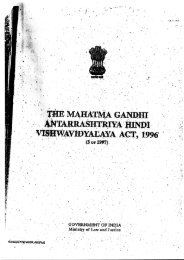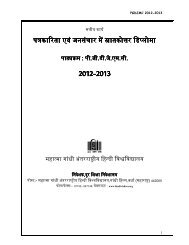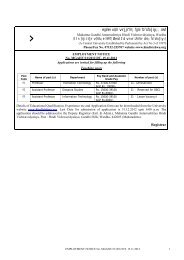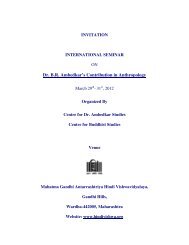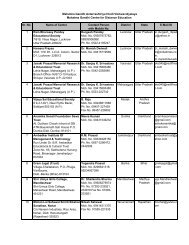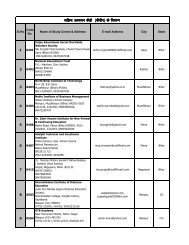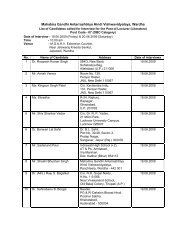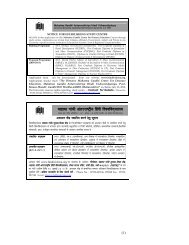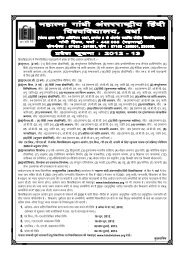A Journal of Mahatma Gandhi Antarrashtriya Hindi Vishwavidyalaya
A Journal of Mahatma Gandhi Antarrashtriya Hindi Vishwavidyalaya
A Journal of Mahatma Gandhi Antarrashtriya Hindi Vishwavidyalaya
Create successful ePaper yourself
Turn your PDF publications into a flip-book with our unique Google optimized e-Paper software.
forces <strong>of</strong> liberty and patriotism triumphing<br />
over the negative forces. The theme <strong>of</strong><br />
“Samman Kise kehte Hain” ripens into<br />
maturity in Premchand’s “Soze Vatan.”<br />
“Ek Tokri Bhar Mitti” is the last <strong>of</strong><br />
Sapreji’s stories. Besides structural brevity,<br />
it also has intensity <strong>of</strong> effect. Although<br />
it deals with social injustice, it expresses<br />
faith in the inherent goodness <strong>of</strong> human<br />
nature. The effect is a transmutation <strong>of</strong><br />
mind and heart. It reflects Premchand’s<br />
initial stories. Madhav Rao’s contribution<br />
to the art <strong>of</strong> story writing is no doubt<br />
noteworthy but, much more important<br />
than that is the fact that he gave a definite<br />
shape to the art <strong>of</strong> literary criticism in<br />
<strong>Hindi</strong>. According to him, Literary Criticism<br />
plays a crucial role in the development<br />
<strong>of</strong> Literature. Therefore, he was always<br />
eager to develop the art <strong>of</strong> Literary<br />
Criticism. He worked diligently to achieve<br />
this end. He wanted to establish a “Nagri<br />
Pracharini Sabha” and a “Samalochana<br />
Society” for the development <strong>of</strong> Literary<br />
Criticism. He also desired the publication<br />
<strong>of</strong> a magazine “Nagri Samalochana.”<br />
Although his dreams remained unfulfilled,<br />
yet in “Chhattisgarh Mitra”, he tried hard<br />
to give a definite shape to the art <strong>of</strong> Literary<br />
Criticism.<br />
Within a short period <strong>of</strong> two years<br />
in1900-1901, around 20 critical reviews<br />
by Sapreji were published—ranging from<br />
poetry and novel to astrology, grammar,<br />
education <strong>of</strong> women etc. He also wrote<br />
a critical review <strong>of</strong> a magazine “Bhasha<br />
Chandrika.”In the March, 1916 <strong>of</strong> “Maryada”<br />
Sapreji’s brilliant review on “Oxford Survey<br />
<strong>of</strong> British Empire” was published. It was<br />
humorously satirical, light-hearted in tone<br />
and full <strong>of</strong> wit. Glancing through the widely<br />
variegated range <strong>of</strong> his works, we come<br />
to the conclusion that his art <strong>of</strong> criticism<br />
was not limited to literature alone. These<br />
reviews establish the fact that he was a<br />
great linguist being well versed in <strong>Hindi</strong>,<br />
Marathi, Sanskrit and English. He has<br />
brilliantly analyzed several literary<br />
translation. Examining “Bharat Gaurav”,<br />
Sapreji has expressed his views on Literary<br />
Criticism in the following manner—“Though<br />
the word critic has a positive meaning,<br />
it is generally associated with having<br />
negative implications. It is generally held<br />
that critical appraisal is akin to finding<br />
loopholes. Whatever be the quality <strong>of</strong> work,<br />
the duty <strong>of</strong> a critic is to set right and<br />
smoothen out the rough edges. This does<br />
not imply that a critic’s work is flawless.<br />
After all, he is human and liable to error.”<br />
In ‘Bharat Mitra’ he writes : “Just as<br />
an appraiser <strong>of</strong> precious stones carefully<br />
examines his gems and evaluates their<br />
worth, similarly brilliant critics examine<br />
literary creation and evaluate its merits<br />
and demerits. This is literary<br />
criticism.”Sapreji has reviewed a number<br />
<strong>of</strong> poems especially those <strong>of</strong> Sridhar Pathak,<br />
who gained immense popularity as an<br />
experimental poet. His poems were both<br />
in ‘Khariboli’ and ‘Brajbhasha’. ‘Dhanvijay’<br />
January-March 2012 :: 23




